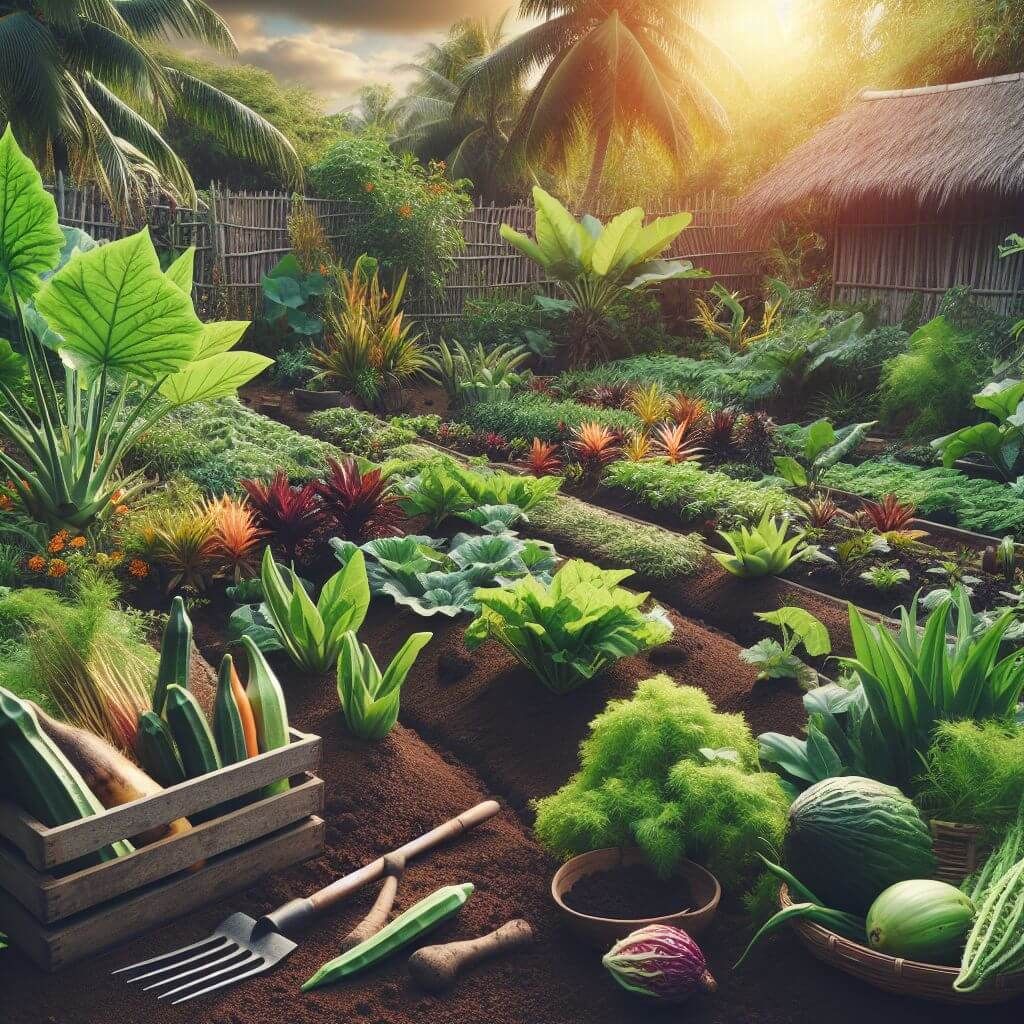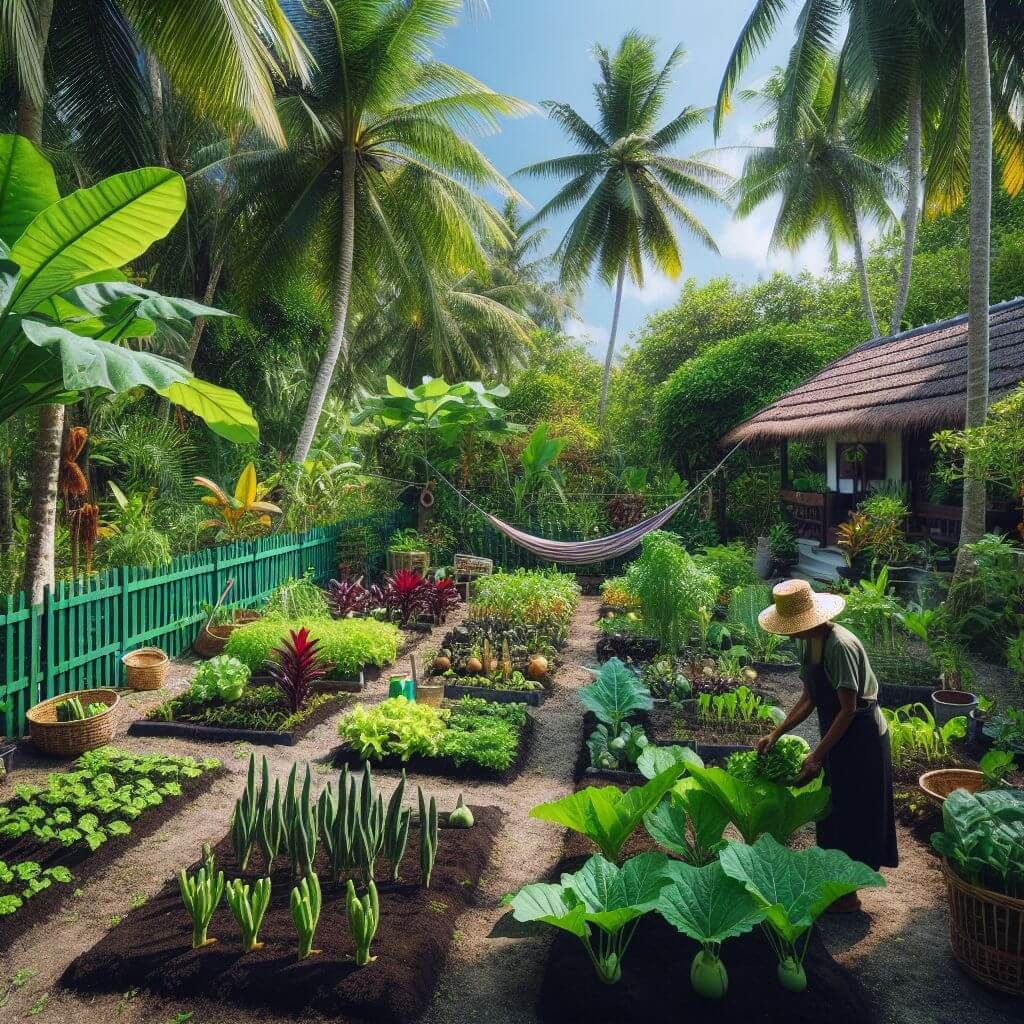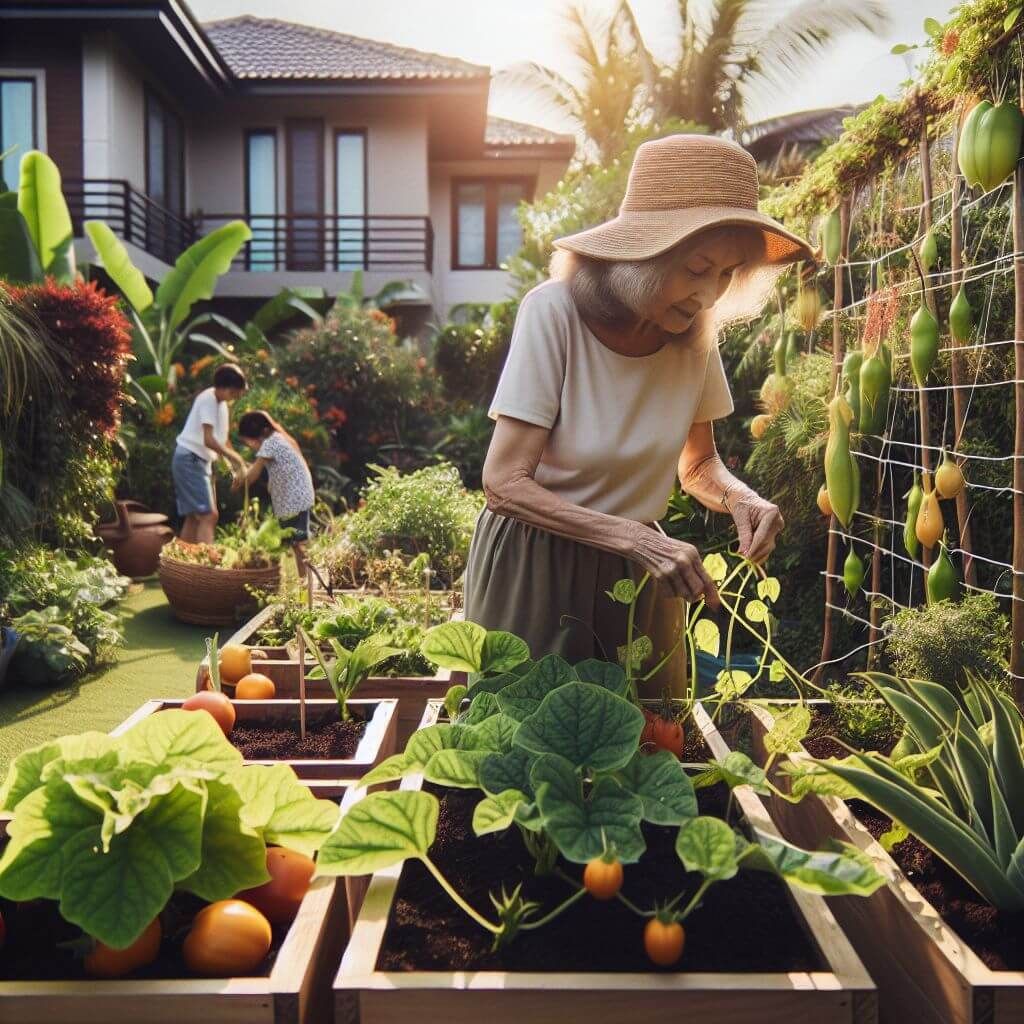
Key Takeaways
Growing tropical vegetables in non-tropical climates is possible with the right knowledge and tools.
Understanding your climate zone and creating microclimates are essential first steps.
Greenhouses and proper containers can provide the necessary environment for tropical plants.
Lighting, watering, and humidity must be managed to simulate tropical conditions.
With care and attention, even beginners can enjoy a bounty of tropical vegetables.
Embracing the Tropical Harvest: Homegrown Delights Away from the Equator
Imagine biting into a juicy, sun-warmed tomato, plucked right from your own garden—a garden that defies the cooler climate you live in, filled with tropical vegetables that transport your taste buds to equatorial lands. It sounds like a dream, doesn’t it? But here’s the thing: with a bit of know-how and determination, you can make this dream a reality, no matter where you are. Let’s dive into the world of tropical vegetable gardening in non-tropical climates.
The Lure of Lush Leaves and Vibrant Veggies
The appeal of tropical vegetables goes beyond their exotic flavors and nutritional benefits; they add an aesthetic of lushness and diversity to your garden. From the vibrant purple of eggplants to the fiery red of chilies, these plants offer a feast for the eyes and the palate. But the question remains, can these sun-loving species truly thrive in your backyard?
The Feasibility Factor: Can It Be Done?
The short answer is yes. With advancements in gardening techniques and a deeper understanding of plant care, growing tropical vegetables outside their native habitat has become more accessible. The key is to recreate the essential conditions that these plants crave: warmth, sunlight, and humidity.
Finding Your Tropical Niche in Cooler Climes

Before you start planting, it’s crucial to assess your local environment. Every region has its unique climate quirks, and understanding these will help you tailor your gardening strategy. Are your summers short and sweet? Do you get frost by September? These are the types of questions that will guide your tropical vegetable journey.
Once you’ve got a handle on your local climate, you can start thinking about which tropical vegetables are up for the challenge. Some plants are more adaptable than others, and choosing the right ones will set you up for success.
For example, many gardeners find that certain varieties of peppers and tomatoes, while not strictly tropical, can flourish with the right care and can add that desired exotic flair to their gardens.
Understanding Your Climate Zone
Your climate zone is like a gardening GPS—it helps you navigate the world of what will grow best in your area. In the United States, the USDA Plant Hardiness Zone Map is a handy reference. It divides the country into zones based on average annual minimum winter temperatures. Find your zone, and you’ll have a clearer idea of the tropical vegetables that can withstand your local conditions.
Matching Tropical Vegetables to Your Environment
When selecting tropical vegetables, consider not just the temperature but also the length of your growing season. Some tropical plants need a long period of warmth to produce a harvest, while others might be content with a shorter, intense summer.
Here are a few tropical vegetables that can adapt to various climates:
Okra: Thrives in heat and can grow in a range of soils.
Chayote: A versatile squash that loves warm weather and can be trellised to save space.
Malabar Spinach: A heat-loving leafy green that can tolerate some shade.
By choosing wisely, you’ll give your tropical vegetables the best shot at success.
Toolkit for Tropical Triumphs
Now that you’ve got your plants picked out, it’s time to gather the tools you’ll need to bring the tropics to your backyard. This means creating the right environment for your vegetables to flourish.
Greenhouse Growing: A Controlled Tropical Haven
A greenhouse is a tropical vegetable’s best friend. It offers control over temperature, humidity, and light—three critical factors for tropical growth. If you have the space and resources, a greenhouse can be a game-changer, allowing you to extend the growing season and protect your plants from chilly nights.
Outdoor Oasis: Creating Microclimates in Your Yard
Even without a greenhouse, you can still create pockets of tropical bliss. By strategically placing your plants near south-facing walls or under cloches and cold frames, you can shield them from the cold and give them the extra warmth they need.
Another trick is to use water jugs painted black, filled with water, and placed near your plants. They’ll absorb heat during the day and release it at night, creating a mini microclimate of warmth.
The Right Containers for Your Tropical Plants
Containers are not just for convenience; they’re a necessity for some tropical vegetables. They allow you to move plants to optimal locations throughout the season and bring them indoors when the weather turns cold. Here’s what to consider when choosing containers:
Size: Ensure the container is large enough to accommodate the plant’s root system.
Material: Terracotta pots are porous and help soil breathe, but they can dry out quickly. Plastic pots retain moisture better but may not provide enough aeration.
Drainage: Good drainage is crucial to prevent root rot. Make sure your containers have holes at the bottom.
With these tools in hand, you’re well on your way to cultivating a tropical paradise, no matter where you live.
The Sunshine Mimic: Lighting for Lush Growth

Let’s talk about the sun’s role in the life of tropical vegetables. They’re sun worshippers, thriving under its bright rays. When we’re growing these heat-loving plants in cooler climates, it’s essential to mimic the intensity and duration of tropical sunlight as closely as possible. This is where lighting comes into play, ensuring your plants get all the light they need to grow strong and healthy.
Optimizing Light Exposure Indoors
If you’re growing tropical vegetables indoors, positioning them near windows that receive ample sunlight is crucial. South-facing windows are typically the best in the Northern Hemisphere, but any spot that gets at least six hours of direct sunlight will do wonders. Remember, though, that window glass can filter out some of the sun’s intensity, so consider this when placing your plants.
Using Grow Lights Effectively
When natural light isn’t enough, grow lights are a gardener’s best friend. They can provide the full spectrum of light that tropical plants crave. Here’s how to use them effectively:
Choose full-spectrum LED lights for energy efficiency and longevity.
Position the lights close to the plants—about 12-24 inches above the foliage—to mimic the intensity of the tropical sun.
Keep the lights on for 12-16 hours a day to simulate a tropical day cycle.
With these tips, you’ll be able to keep your tropical vegetables basking in the glow they need to produce those delicious, vibrant fruits and veggies.
Water Wonders and Humidity Hacks
Water is the lifeblood of tropical vegetables, and getting the watering right is critical. These plants are used to regular rainfall and high humidity, so replicating these conditions will keep them happy and productive.
For instance, a gardener in a drier climate successfully grew luscious papayas by using a drip irrigation system and misting the leaves regularly to maintain high humidity around the plants.
Let’s look at some ways to ensure your tropical plants get the hydration they need without overdoing it.
Firstly, it’s important to water deeply but less frequently, allowing the soil to dry out slightly between waterings. This encourages strong root growth as the plants reach down for moisture.
Secondly, mulching around your plants will help retain soil moisture and regulate temperature—organic mulches like straw or wood chips are perfect for this.
Watering Rhythms for Rainforest Residents
Creating a consistent watering schedule that mimics the natural rainfall patterns of a tropical climate can make all the difference. Early morning is the best time to water, as it allows the foliage to dry out during the day, reducing the risk of fungal diseases. For potted plants, ensure there’s proper drainage so their “feet” don’t stay wet, which could lead to root rot.
DIY Humidity Trays for That Tropical Touch
Humidity can be a challenge, especially in indoor environments. One simple solution is to create a humidity tray: fill a shallow tray with pebbles and water, then set your plant’s container on top. As the water evaporates, it creates a humid microclimate around your plant. Just make sure the pot isn’t sitting in water, as this could cause root issues.
Nurturing Through Nutrients: Fertilizers and Feeding
Tropical vegetables are not just thirsty; they’re hungry, too. They grow quickly and need plenty of nutrients to support that growth. Regular feeding with the right fertilizers will keep them lush and productive.
Here’s a simple guide to fertilizing tropical vegetables:
Use a balanced, water-soluble fertilizer every two to four weeks during the growing season.
Compost and well-rotted manure are excellent organic options that provide a slow-release source of nutrients.
For heavy feeders like tomatoes and peppers, consider a fertilizer higher in potassium and phosphorus to encourage fruiting.
By feeding your tropical vegetables the nutrients they need, you’ll be rewarded with a bountiful harvest that’s as nutritious as it is delicious.
Identifying Nutrient Needs for Tropical Vegetables
Each tropical vegetable has its own specific nutrient requirements. Leafy greens, for example, need a good supply of nitrogen for lush foliage, while fruiting plants benefit from potassium to help develop those tasty fruits. It’s important to research the needs of each plant and adjust your feeding regimen accordingly.
Yellowing leaves or stunted growth can be signs that your plants are lacking in certain nutrients. Being attentive to these signals and responding with the appropriate fertilizers can keep your tropical vegetables thriving.
Organic vs. Synthetic Fertilizers: The Lowdown
When it comes to fertilizers, you have two main choices: organic or synthetic. Organic fertilizers, like fish emulsion or bone meal, release nutrients slowly and improve soil structure over time. Synthetic fertilizers provide a quick nutrient boost but can build up in the soil and potentially harm beneficial microorganisms.
Most importantly, whichever type you choose, follow the instructions carefully to avoid over-fertilization, which can be just as detrimental as under-fertilization.
The Best Tropical Vegetables for Your Garden
Now that we’ve covered the how-to’s, let’s talk about the what’s. There are so many tropical vegetables to choose from, but here are a few that are particularly well-suited to growing in non-tropical climates:
Enchanting eggplants, with their glossy purple skins; kaleidoscopic chilies, offering a spectrum of heat and color; and tropical tomatoes, basking in the sun and defying cooler climates. These are just the beginning of a long list of tropical vegetables that you can grow right in your own backyard.
Eggplants: Choose a fast-maturing variety for shorter growing seasons.
Chilies: From sweet to scorching, they can be grown in pots and moved indoors if needed.
Tropical Tomatoes: Opt for varieties that can tolerate temperature fluctuations.
With these plants, you can create a tropical tapestry that’s not only beautiful but also bountiful.
Enchanting Eggplants: Varieties for the Voracious Grower
Eggplants are a tropical vegetable that can adapt surprisingly well to less-than-tropical conditions. They love warmth, so starting them indoors and transplanting them outside after the last frost is a good strategy. Look for varieties like ‘Fairy Tale’ or ‘Little Fingers’ that are known for their quick maturation and compact growth—perfect for the eager gardener looking to harvest a taste of the tropics.
Remember, tropical vegetables are more than just plants; they’re a ticket to an exotic, flavorful world. With the right care, you can grow a tropical feast, no matter where your garden is planted.
Germination Geriatrics: Helping Tropical Seeds Sprout
Germinating tropical seeds can sometimes feel like you’re coaxing life out of a stone. They often require more warmth and consistent moisture than their temperate counterparts. A heat mat can be a tropical seed’s best friend, providing the steady warmth they need to break dormancy. Also, soaking seeds overnight can soften tough outer shells and speed up germination. Patience is key here—some tropical seeds take their sweet time to sprout, but the wait is worth it when you see those first signs of green.
Battling Pests and Diseases in Non-Tropical Zones
Even the best gardeners face the challenge of pests and diseases, and tropical vegetables are no exception. Because these plants are not native to cooler climates, they may lack natural defenses against local pests. Integrated Pest Management (IPM) is a sustainable approach to managing pests that combines biological control, habitat manipulation, and the use of resistant varieties. Always inspect your plants regularly for signs of trouble and act swiftly to keep issues under control. Neem oil, insecticidal soaps, and encouraging beneficial insects can be effective ways to protect your tropical treasures.
Tales from the Tropics: Real-life Success Stories
There’s nothing quite like hearing success stories to boost your confidence. Take Sarah, for example, who lives in the Pacific Northwest and successfully grows a variety of tropical vegetables in her backyard greenhouse. She’s mastered the art of creating a microclimate that includes raised beds, a drip irrigation system, and a heat retention strategy that involves water barrels and thermal mass.
Then there’s Miguel, in the Midwest, who turns his urban patio into a tropical escape every summer. With a collection of containers, he grows everything from chilies to okra, and even a small banana plant that he brings indoors during the winter months.
Case Studies: Gardeners Who’ve Made It Work
These stories aren’t just inspiring—they’re instructional. For instance, a gardener in Maine has found that by using a combination of cold frames and heavy mulching, she can grow ginger and turmeric, both of which are tropical rhizomes. She starts them indoors early in the season and then transfers them outside once the threat of frost has passed.
Another gardener in Colorado uses a passive solar greenhouse to grow passion fruit vines. The key to his success is a well-insulated structure that captures heat during the day and releases it slowly at night, ensuring that the temperature never drops too low for his tropical plants.
From Greenhouse to Plate: Sharing Inspiring Journeys
It’s not just about the growing; it’s about the entire journey from seed to plate. These gardeners don’t just grow vegetables; they create recipes and share meals that celebrate their harvest. Sarah, for instance, hosts an annual “Taste of the Tropics” potluck where friends and neighbors sample dishes made from her greenhouse-grown produce.
Frequently Asked Questions
When embarking on the adventure of growing tropical vegetables, questions abound. Let’s tackle some of the most common queries to help clear the path for your gardening success.
Can tropical vegetables really thrive in cold climates?
Yes, they can! With the right techniques and persistence, you can create conditions that mimic a tropical environment. This may involve using greenhouses, cold frames, and choosing the right varieties that can adapt to cooler temperatures. The key is to understand the needs of each plant and provide as close to their native conditions as possible.
What are the easiest tropical vegetables to grow for beginners?
For those just starting out, some tropical vegetables are more forgiving and easier to grow than others. Consider starting with:
Peppers, both sweet and hot, which are quite resilient and can be grown in pots.
Tomatoes, particularly cherry or grape varieties, which are robust and prolific.
Herbs like basil and cilantro, which grow quickly and don’t need as much heat as other tropical plants.
How often should I water my tropical plants?
Watering needs can vary based on the plant species, the size of the plant, and the climate you’re in, but a general rule of thumb is to water when the top inch of soil feels dry to the touch. Overwatering can be just as harmful as underwatering, so make sure your pots have good drainage and that you’re monitoring soil moisture levels regularly.
Do tropical vegetables need special soil or fertilizers?
Tropical vegetables often thrive in rich, well-draining soil. Amending your garden soil with compost or well-rotted manure can provide the nutrients these plants need. As for fertilizers, a balanced, slow-release type can work wonders, but you should also consider the specific needs of each plant. Some may benefit from a boost of potassium or nitrogen at different stages of their growth.
Are there pest-resistant varieties of tropical vegetables?
While no plant is completely pest-proof, some varieties of tropical vegetables have been bred for increased resistance to common pests and diseases. When selecting seeds or plants, look for those that list resistance traits. This can save you a lot of trouble down the line and make your tropical gardening experience that much more enjoyable.







Leave a Reply